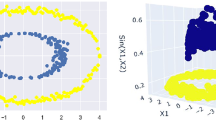Abstract
Dot product kernels are a class of important kernel in the theory of support vector machine. This paper develops a method to construct the mapping that map the original data set into the high dimensional feature space, on which the inner product is defined by a dot product kernel. Our method can also be applied to the Gaussian kernels. Via this mapping, the structure of features in the feature space is easy to be observed, and the linear separability of data sets in the feature space is studied. We obtain that any two finite sets of data with empty overlap in the original space will become linearly separable in an infinite dimensional feature space, and a sufficient and necessary condition is also developed for two infinite sets of data in the original data space being linearly separable in the feature space, this condition can be applied to examine the existences and uniqueness of the hyperplane which can separate all the possible inputs correctly.
Preview
Unable to display preview. Download preview PDF.
Similar content being viewed by others
References
Vapnik, V.N.: The Nature of Statistical Learning Theory. Springer, New York (1995)
Vapnik, V.N.: Statistical Learning Theory. Wiley, New York (1998)
Burges, C.: A Tutorial on Support Vector Machines for Pattern Recognition. Data Mining and Knowledge Discovery 2(2), 121–167 (1998)
Schurmann, J.: Pattern Classification: A Unified View of Statistical and Neural Approaches. Wiley, New York (1996)
Micchelli, C.A.: Algebraic Aspects of Interpolation. In: Proceedings of Symposia in Applied Mathematics, vol. 36, pp. 81–102 (1986)
Scholkopf, B., Smola, A.J.: Learning with Kernels. MIT Press, Cambridge (2002)
Smola, A.J.: Regression Estimation with Support Vector Learning Machines, Diplomarbeit, Technische Universitat Munchen (1996)
Schoenberg, I.J.: Positive Definite Functions on Spheres. Duke Mathematical Journal 9, 96–108 (1942)
Steinwart, I.: On the Influence of the Kernel on the Consistency of Support Vector Machines. Journal of Machine Learning Research 2, 67–93 (2001)
Saunders, C., Stitson, M.O., Weston, J., Bottou, L., Scholkopf, B., Smola, A.J.: Support Vector Machine Reference Manual. Technical Report CSD-TR-98-03, Department of Computer Science, Royal Holloway, University of London, Egham, UK (1998)
Degang, C., Qiang, H., Xizhao, W.: The infinite polynomial kernel for support vector machine. In: Li, X., Wang, S., Dong, Z.Y. (eds.) ADMA 2005. LNCS (LNAI), vol. 3584, pp. 267–275. Springer, Heidelberg (2005)
Hein, M., Bousquet, O., Scholkopf, B.: Maximal margin classification for metric spaces. Journal of Computer and System Sciences 71, 333–359 (2005)
Micchelli, C.A.: Algebraic aspects of interpolation. In: Proceedings of Symposia in Applied Mathematics, vol. 36, pp. 81–102 (1986)
Author information
Authors and Affiliations
Editor information
Editors and Affiliations
Rights and permissions
Copyright information
© 2006 Springer-Verlag Berlin Heidelberg
About this paper
Cite this paper
Chen, D., He, Q., Dong, C., Wang, X. (2006). A Method to Construct the Mapping to the Feature Space for the Dot Product Kernels. In: Yeung, D.S., Liu, ZQ., Wang, XZ., Yan, H. (eds) Advances in Machine Learning and Cybernetics. Lecture Notes in Computer Science(), vol 3930. Springer, Berlin, Heidelberg. https://doi.org/10.1007/11739685_96
Download citation
DOI: https://doi.org/10.1007/11739685_96
Publisher Name: Springer, Berlin, Heidelberg
Print ISBN: 978-3-540-33584-9
Online ISBN: 978-3-540-33585-6
eBook Packages: Computer ScienceComputer Science (R0)




